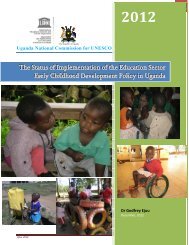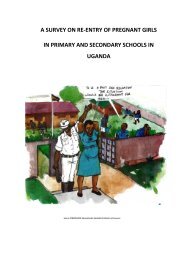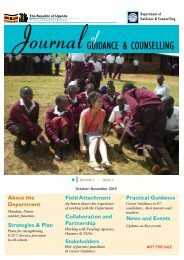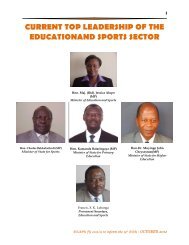Download Pdf - Ministry of Education and Sports
Download Pdf - Ministry of Education and Sports
Download Pdf - Ministry of Education and Sports
You also want an ePaper? Increase the reach of your titles
YUMPU automatically turns print PDFs into web optimized ePapers that Google loves.
xvii<br />
(iii)<br />
which 46% are female; <strong>and</strong>,<br />
Whereas the proportion <strong>of</strong> girls enrolled in S.1 is tending to parity at 47%, this proportion<br />
progressively decreases towards upper secondary.<br />
<strong>Education</strong> for all (EFA) Goals<br />
Status & trends for Goal 1:<br />
In 2001/2002, only 59,829 (male 29,589; female 253,039) pupils were enrolled in the PrePrimary subsector<br />
however by 2009/10 the enrolment had multiplied by seven times. In FY 2011/12, the enrolment<br />
increased to 345,295 (male 170,245; female 175,050). The increase in enrolment is mainly attributed to<br />
government efforts to promote Early Childhood Development over the last four years.<br />
Status & trends for Goal 2:<br />
(i) By 2010, the enrolment had increased to over 8 million children, an increase <strong>of</strong> 28% (23% male; 33%<br />
female). The 2012 annual school census exercise revealed that a total <strong>of</strong> 8.3 million children were<br />
enrolled in school;<br />
(ii)<br />
The proportion <strong>of</strong> children successfully completing P7 increased from 64 % (65% male; 63% female)<br />
in 2011 to 67% (68% male; 66% female) in 2012; <strong>and</strong>,<br />
(iii) Total number <strong>of</strong> teachers on payroll increased from 129,651 in 2011 to 131,665 teachers in 2012.<br />
This improves the PTR by 1 point (i.e. 54:1 in 2011 to 53:1 in 2012).<br />
Status & trends for Goal 3:<br />
(i)<br />
Enrolment in secondary schools currently (2012), st<strong>and</strong>s at 1,225,326 (657,644 male; 567,682 female);<br />
the proportion <strong>of</strong> female enrolment at tertiary level has grown more rapidly than at secondary<br />
level. In 2000, the proportion <strong>of</strong> female enrolment was 36.7% <strong>and</strong> now st<strong>and</strong>s at 44%. There is<br />
however a high chance that the gender gap <strong>of</strong> 8 percent in favor <strong>of</strong> boys (54%) at secondary<br />
education level could be eliminated by 2015. The gender gap (12%) at tertiary education requires<br />
additional affirmative action to eliminate.<br />
Status & trends for Goal 4:<br />
(i) In 2010, the percentage <strong>of</strong> literate Ug<strong>and</strong>ans had improved to 74.6% (82.4% male; 66.8% female)<br />
which translates into a percentage point improvement <strong>of</strong> 6.6 % (4.4% male; 7.8% female); <strong>and</strong>,<br />
(ii) The percentage <strong>of</strong> literate Ug<strong>and</strong>ans aged 1524 years increased from 81% (86% male; 76%<br />
female) in 2005 to 87.3% (89.1% male; 85.5% female) in 2010 which translates into a percentage<br />
point improvement <strong>of</strong> 6.3 % (3.1% male; 9.5% female). It is apparent that Ug<strong>and</strong>a has already<br />
achieved a 50% improvement in literacy levels. By 2015, it is expected that at least 80% <strong>of</strong> the adult<br />
population will be literate.<br />
Status & trends for Goal 5:<br />
(i)<br />
(ii)<br />
The gender gap in the primary education sub sector has finally been closed. The number <strong>of</strong> girls<br />
<strong>and</strong> boys isnow equal in all classes; <strong>and</strong>,<br />
The gender gap in secondary education subsector has, between 2006 <strong>and</strong> 2009, been oscillating<br />
around 45% for girls <strong>and</strong> 55% for boys.<br />
ESSAPR FY 2011/12 to inform the 19 th ESSR – OCTOBER 2012








